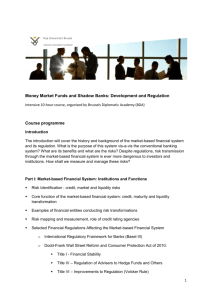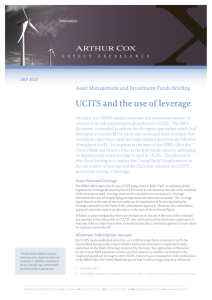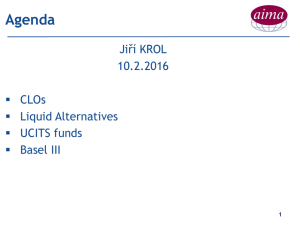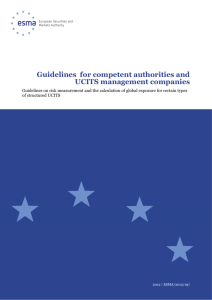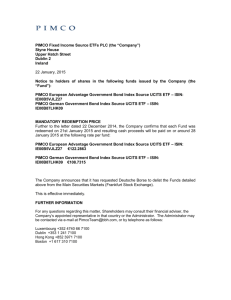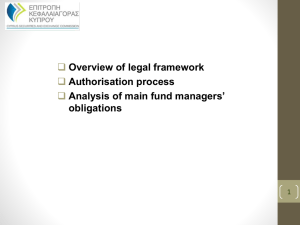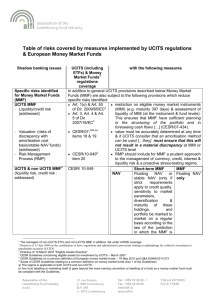Increasing Investor Disclosure Requirements and Restrictions for UCITS Funds
advertisement
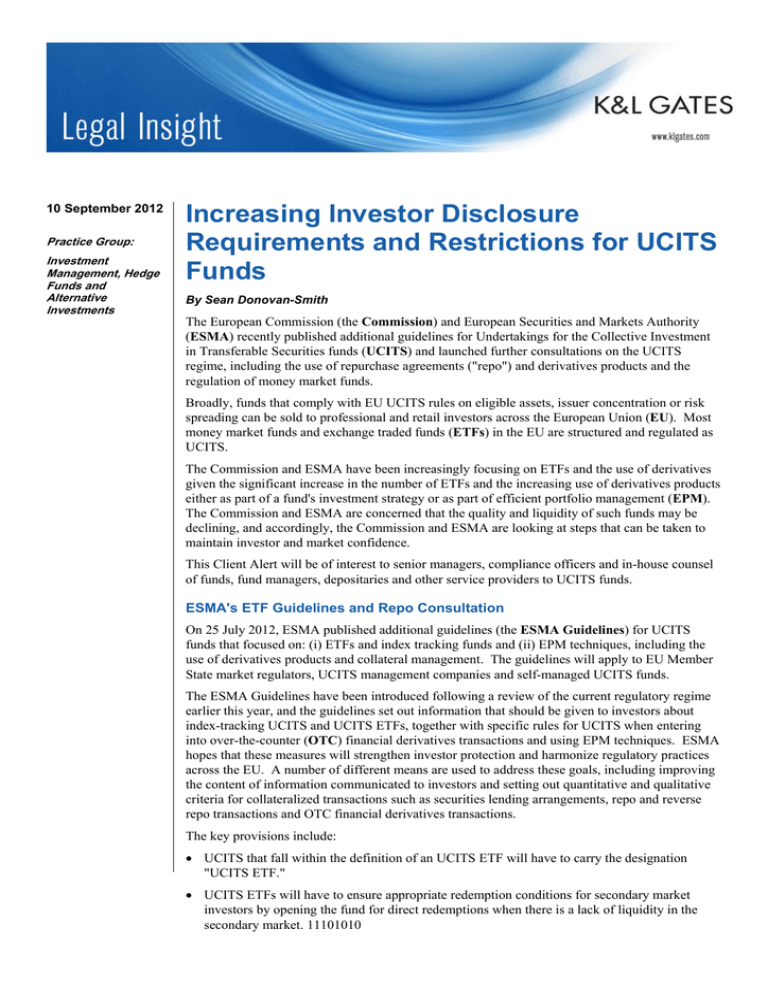
10 September 2012 Practice Group: Investment Management, Hedge Funds and Alternative Investments Increasing Investor Disclosure Requirements and Restrictions for UCITS Funds By Sean Donovan-Smith The European Commission (the Commission) and European Securities and Markets Authority (ESMA) recently published additional guidelines for Undertakings for the Collective Investment in Transferable Securities funds (UCITS) and launched further consultations on the UCITS regime, including the use of repurchase agreements ("repo") and derivatives products and the regulation of money market funds. Broadly, funds that comply with EU UCITS rules on eligible assets, issuer concentration or risk spreading can be sold to professional and retail investors across the European Union (EU). Most money market funds and exchange traded funds (ETFs) in the EU are structured and regulated as UCITS. The Commission and ESMA have been increasingly focusing on ETFs and the use of derivatives given the significant increase in the number of ETFs and the increasing use of derivatives products either as part of a fund's investment strategy or as part of efficient portfolio management (EPM). The Commission and ESMA are concerned that the quality and liquidity of such funds may be declining, and accordingly, the Commission and ESMA are looking at steps that can be taken to maintain investor and market confidence. This Client Alert will be of interest to senior managers, compliance officers and in-house counsel of funds, fund managers, depositaries and other service providers to UCITS funds. ESMA's ETF Guidelines and Repo Consultation On 25 July 2012, ESMA published additional guidelines (the ESMA Guidelines) for UCITS funds that focused on: (i) ETFs and index tracking funds and (ii) EPM techniques, including the use of derivatives products and collateral management. The guidelines will apply to EU Member State market regulators, UCITS management companies and self-managed UCITS funds. The ESMA Guidelines have been introduced following a review of the current regulatory regime earlier this year, and the guidelines set out information that should be given to investors about index-tracking UCITS and UCITS ETFs, together with specific rules for UCITS when entering into over-the-counter (OTC) financial derivatives transactions and using EPM techniques. ESMA hopes that these measures will strengthen investor protection and harmonize regulatory practices across the EU. A number of different means are used to address these goals, including improving the content of information communicated to investors and setting out quantitative and qualitative criteria for collateralized transactions such as securities lending arrangements, repo and reverse repo transactions and OTC financial derivatives transactions. The key provisions include: UCITS that fall within the definition of an UCITS ETF will have to carry the designation "UCITS ETF." UCITS ETFs will have to ensure appropriate redemption conditions for secondary market investors by opening the fund for direct redemptions when there is a lack of liquidity in the secondary market. 11101010 Increasing Investor Disclosure Requirements and Restrictions for UCITS Funds UCITS using EPM techniques such as securities lending activities will have to inform investors clearly about such activities and the related risks, (EPM activities include securities lending and repo transactions, as well as the management of collateral that is received or granted to secure these transactions). All revenues net of operating costs generated by EPM activities must be returned to the UCITS fund. When a UCITS enters into securities lending arrangements, it should be able at any time to recall any securities lent or terminate any agreement into which it has entered. UCITS receiving collateral to mitigate counterparty risk from OTC financial derivatives transactions or EPM activities must ensure that the collateral complies with strict qualitative criteria and specific limits in relation to diversification (which amend certain aspects of the existing Guidelines on Risk Measurement and Calculation of Global Exposure and Counterparty Risk for UCITS (CESR/10-788)). UCITS investing in financial indices will have to ensure that investors are provided with the full calculation methodology of such indices, and UCITS funds must only invest in financial indices which respect strict criteria regarding, among other matters, the rebalancing frequency and their diversification. In addition to the ESMA Guidelines, ESMA simultaneously published a further consultation on the use of repo and reverse repo arrangements by UCITS funds. ESMA is consulting on a distinct regime for repo and reverse repo arrangements which would allow a proportion of the assets of the UCITS to be non-recallable at any time at the initiative of the UCITS. The proposed guidelines include safeguards to ensure that the counterparty risk arising from these arrangements is limited and that UCITS entering into such arrangements can continue to execute redemption requests. The consultation in relation to repos and reverse repos is open for comment until 25 September 2012. Once adopted, the proposals on repo and reverse repo arrangements will be integrated into the ESMA guidelines in order to have a single package of rules. The final guidelines, comprising the new ESMA Guidelines and the rules on repo and reverse repo agreements will become effective two months after publication on the ESMA website. The ESMA Guidelines can be found here. Commission Consultation on UCITS Funds On 26 July 2012, the Commission announced a further consultation on investment fund issues (the Commission Consultation) subsequent to its ongoing work on shadow banking and a previous consultation on investment funds published on 19 March 2012. The Commission Consultation is separate from the Commission's proposals adopted on 3 July 2012 focusing on specific issues of UCITS depositary, remuneration and sanctions and the Commission Consultation builds on and is complementary to the ESMA Guidelines outlined above. The Commission Consultation raises a series of issues and policy options aimed at maintaining investor confidence in money market funds, including the role of money market funds in the management of liquidity for investors, their engagement in the securities lending and repo markets, their systemic involvement in the overall financial marketplace and issues with various methods for calculating the net asset value for money market funds. The Commission Consultation also seeks further feedback on the use of EPM techniques by UCITS fund managers to deepen its insight into the potential systemic and investor implications raised by the use of EPM. 2 Increasing Investor Disclosure Requirements and Restrictions for UCITS Funds The Commission Consultation seeks feedback on a number of issues, including: the regulation of money market funds, including valuation, liquidity and redemptions; EPM and securities lending and repo arrangements, including risk diversification requirements and collateral issues; central clearing of OTC derivatives and counterparty risk; liquidity and redemption management, including time limits, suspensions, deferred redemptions and guaranteed liquidity for ETF UCITS funds; the introduction of a "depository" passport; the notification provisions introduced by UCITS IV; the retailisation of UCITS funds that use "eligible assets"; and providing a framework to support long-term investments. The Commission Consultation is open until 18 October 2012. The Commission Consultation can be found here. Next Steps Although expressed as "guidelines", EU Member State regulators will have regard to them when assessing a firm's compliance with the applicable UCITS regulations and as such firms within the scope of the ESMA Guidelines should ensure that they comply with them. Any new UCITS fund's created after the date of application of the ESMA Guidelines should comply immediately. Existing UCITS funds are required to make any applicable amendments to their investments or documentation within 12 months of the application date of the guidelines. (Note that some provisions will nevertheless apply earlier. For example, existing UCITS ETFs should comply with the provisions related to the treatment of secondary market investors from the application date of the ESMA Guidelines). Accordingly, UCITS funds that fall within the scope of the proposed changes should ensure that their fund documentation includes the prescribed information and is clearly labeled as appropriate. UCITS fund managers must also ensure that any profits generated by EPM activities are for the benefit of the UCITS funds that they manage, and such managers will need to ensure that repo and reverse repo arrangements comply with the new EMSA Guidelines. This may impact on costs for funds as some providers of securities lending services have previously retained a percentage of the fee income for themselves. At a minimum, the new ESMA Guidelines are likely to lead to at least some increased compliance costs for UCITS funds and UCITS fund managers. Interested parties who wish to comment on the consultation should do so by the relevant dates above. If you would like to discuss any of the issues raised in this Legal Insight, please contact one of our team below. 3 Increasing Investor Disclosure Requirements and Restrictions for UCITS Funds Author: Sean Donovan-Smith sean.donovansmith@klgates.com +44 (0)20 7360 8202 Contacts: Martin Cornish Phillip Morgan Alice Bell martin.cornish@klgates.com +44 (0)20 7360 8162 phillip.morgan@klgates.com +44 (0)20 7360 8123 alice.bell@klgates.com +44 (0)20 7360 8304 4
